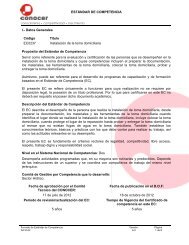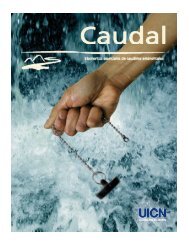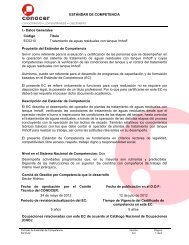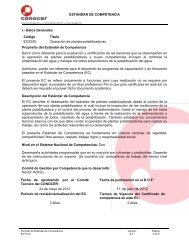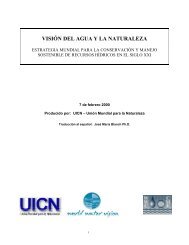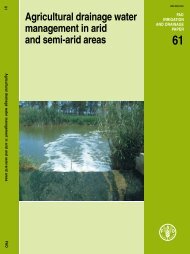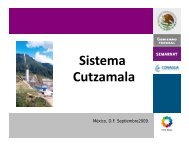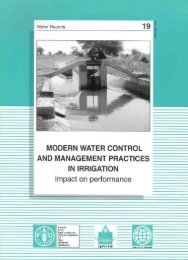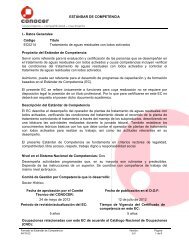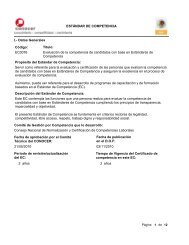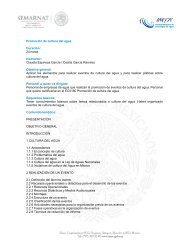4. Fauna <strong>of</strong> MadugangaSpecies composition and relative abundance <strong>of</strong> vertebrate faunaA total <strong>of</strong> 248 species <strong>of</strong> vertebrate fauna, belong<strong>in</strong>g to 121 families were recorded fromMaduganga. These <strong>in</strong>cluded 20 species (8 %) <strong>of</strong> endemics, while 30 species (12 %) arenationally threatened (<strong>IUCN</strong> Sri Lanka, 2000). Among <strong>the</strong> endemic vertebrate species atMaduganga, 70% are nationally threatened. A comparison <strong>of</strong> <strong>the</strong> status <strong>of</strong> vertebrate fauna <strong>of</strong>Sri Lanka and <strong>in</strong> <strong>the</strong> Maduganga wetland is shown <strong>in</strong> Table 4. The native vertebrate fauna <strong>of</strong>Maduganga represents 30% <strong>of</strong> Sri Lanka’s native <strong>in</strong>land vertebrate species. This is a significantproportion, when consider<strong>in</strong>g <strong>the</strong> size <strong>of</strong> this wetland. It is <strong>in</strong>terest<strong>in</strong>g to note that about 42%<strong>of</strong> <strong>the</strong> vertebrate species documented dur<strong>in</strong>g <strong>the</strong> present survey are new records to <strong>the</strong>Maduganga wetland. Compared to <strong>the</strong> survey carried out by <strong>the</strong> Central EnvironmentalAuthority (CEA, 1997), <strong>the</strong> present survey enabled to document a higher number <strong>of</strong> fish andbird species.Table 4A comparison <strong>of</strong> vertebrate fauna <strong>in</strong> Sri Lanka and Maduganga wetland.Group Sri Lanka MadugangaFish Freshwater 78 (32E,39T) 70 1 (2E, 2T)Amphibians 58 (38E, 33T) 12 (3E, 4T)Reptiles 155 (81E, 86T) 31 (7E, 11T)Birds 226 + 200 WM (23E,61T) 111 (13 WM, 6E, 7T)Mammals 90 (14E, 34T) 24 (2E, 6T)E - Endemic, T - Threatened (<strong>IUCN</strong> - SL, 2000), WM - W<strong>in</strong>ter migrant1Fish species - Freshwater, brackish water & mar<strong>in</strong>e species.The fish consisted <strong>of</strong> 70 species belong<strong>in</strong>g to 41 families (Appendix 3). Among <strong>the</strong>m, twospecies are endemic, two are nationally threatened, while 1 species is exotic. The fish <strong>in</strong>cludefreshwater forms, brackish water forms, fresh-brackish water forms and mar<strong>in</strong>e-brackishmigratory species. The typical freshwater species <strong>in</strong>cluded Striped Rasbora (Rasboradaniconius), Giant Danio (Danio malabaricus), Horandandiya (Horadandiya atukarali), Barbs(Puntius spp.) and <strong>the</strong> Walk<strong>in</strong>g Catfish (Clarias brachysoma). These were observed only <strong>in</strong> <strong>the</strong>uppermost (north-east) reaches <strong>of</strong> Maduganga where water sal<strong>in</strong>ity is comparatively lower, dueto <strong>the</strong> <strong>in</strong>flow <strong>of</strong> freshwater from streams. About one third (23 species) <strong>of</strong> <strong>the</strong> fish species <strong>in</strong>Maduganga consist <strong>of</strong> typical brackish water forms such as <strong>the</strong> ambassids (Ambassis spp.),Pony fish (Leiognathus spp.), Mono (Monodactylus argenteus), Target fish (Therapon jabua),Mud skipper (Periopthalmus koelrenteri) and <strong>the</strong> Milk fish (Chanos chanos).11
The migratory species <strong>in</strong>clude both “catadromous” species (species that migrate from fresh tomar<strong>in</strong>e habitats for reproduction) and “anadromous” species (mar<strong>in</strong>e species which move <strong>in</strong>tobrackish/fresh water for spawn<strong>in</strong>g or to spend <strong>the</strong>ir juvenile period). A typical catadromousspecies <strong>in</strong>clude <strong>the</strong> Short-f<strong>in</strong>ned Eel (<strong>An</strong>guilla bicolor), while anadromous species <strong>in</strong>clude <strong>the</strong>Snappers (Lutjanus spp.), Trevally (Caranx spp.), Silver Beddy (Gerres spp.), Surgeon fish(Acanthurus spp.) and Barracuda (Sphyraena spp.).The amphibians consisted <strong>of</strong> 12 species belong<strong>in</strong>g to 4 families (Appendix 4), <strong>in</strong>clud<strong>in</strong>g toads,narrow-mou<strong>the</strong>d frogs, aquatic frogs and tree frogs. These represent approximately 22% <strong>of</strong> <strong>the</strong>total amphibian species <strong>in</strong> <strong>the</strong> island. Among <strong>the</strong>m, 3 species are endemic, while 5 species arenationally threatened.The reptiles consisted <strong>of</strong> 31 species belong<strong>in</strong>g to 12 families (Appendix 5), cover<strong>in</strong>g 20% <strong>of</strong><strong>the</strong> island’s reptilian fauna. These <strong>in</strong>cluded 19 species <strong>of</strong> tetrapod reptiles and 12 species <strong>of</strong>serpents. Among <strong>the</strong> total species, 7 are endemic, while 11 are nationally threatened. The WaterMonitor (Varanus salvator) is <strong>the</strong> most common reptile <strong>in</strong> Maduganga. Breed<strong>in</strong>g populations<strong>of</strong> <strong>the</strong> two species <strong>of</strong> crocodiles (Estuar<strong>in</strong>e Crocodile - Crocodylus porosus and Mugger - C.palustris) also occurs <strong>in</strong> Maduganga. Among <strong>the</strong> o<strong>the</strong>r reptiles, <strong>the</strong> Indian Python (Pythonmolurus) and <strong>the</strong> Sri Lanka Kangaroo lizard (Otocryptis weigmanni) are two rare reptiles thatoccur <strong>in</strong> <strong>the</strong> remnant patch <strong>of</strong> lowland ra<strong>in</strong>forest located <strong>in</strong> <strong>the</strong> upper reaches <strong>of</strong> Maduganga.Maduganga harbours a rich avifauna. A total <strong>of</strong> 111 species belong<strong>in</strong>g to 48 families(Appendix 6) were recorded dur<strong>in</strong>g <strong>the</strong> survey, which is much higher than <strong>the</strong> number recordedby Siriwardena <strong>in</strong> 1997. These represented approximately 43% <strong>of</strong> Sri Lanka’s native avifauna.Of <strong>the</strong> native species, 6 are endemic, while 7 are nationally threatened. About 10% (13species) <strong>of</strong> <strong>the</strong> total bird species <strong>in</strong> Maduganga consisted <strong>of</strong> w<strong>in</strong>ter migrants. The mixture <strong>of</strong>vegetation types <strong>in</strong> <strong>the</strong> islands and <strong>the</strong> surround<strong>in</strong>g ma<strong>in</strong>land area, toge<strong>the</strong>r with <strong>the</strong> estuary,has made Maduganga an ideal ecotone for a variety <strong>of</strong> birds. About 35% <strong>of</strong> <strong>the</strong> bird speciesrecorded <strong>in</strong>cluded those associated with wetland ecosystems, such as herons, egrets,cormorants, teals, waders, k<strong>in</strong>gfishers and terns that feed on aquatic organisms. The islands <strong>in</strong><strong>the</strong> estuary serve as an ideal roost<strong>in</strong>g site for <strong>the</strong> above species. A notable feature <strong>of</strong> <strong>the</strong> speciescomposition <strong>of</strong> avifauna <strong>in</strong> Maduganga is <strong>the</strong> low occurrence <strong>of</strong> waders, which may be relatedto <strong>the</strong> lack <strong>of</strong> a shorel<strong>in</strong>e and mudflats around <strong>the</strong> islands and ma<strong>in</strong>land areas, which are <strong>the</strong>preferred habitats <strong>of</strong> wad<strong>in</strong>g birds.The mammals <strong>of</strong> Maduganga consisted <strong>of</strong> 24 species belong<strong>in</strong>g to 16 families (Appendix 7),represent<strong>in</strong>g approximately 26% <strong>of</strong> <strong>the</strong> island’s mammalian fauna. Among <strong>the</strong>m, 2 species areendemic, while 6 species are considered nationally threatened. The ma<strong>in</strong>land area <strong>of</strong>Maduganga is one <strong>of</strong> <strong>the</strong> few refuges <strong>of</strong> <strong>the</strong> threatened Hog Deer (Axis porc<strong>in</strong>us). The smallpatch <strong>of</strong> remnant lowland ra<strong>in</strong>forest <strong>in</strong> <strong>the</strong> upper reaches <strong>of</strong> Maduganga harbours three species<strong>of</strong> threatened arboreal mammals (Purple-faced Leaf Monkey - Trachypi<strong>the</strong>cus vetulus, GoldenPalm Civet - Paradoxurus zeylonensis and <strong>the</strong> Slender Loris - Loris tardigradus). The areaalso serves as an important refuge <strong>of</strong> three carnivorous mammals - <strong>the</strong> Fish<strong>in</strong>g Cat(Prionailurus viverr<strong>in</strong>us), Eurasian Otter (Lutra lutra) and <strong>the</strong> Jackal (Canis aureus). Apart12



